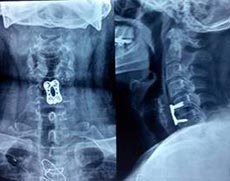
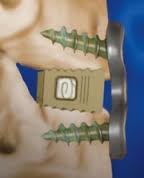 This is a standard spine surgical procedure where your cervical spine is operated from the front. The incision is then taken in your neck region and vertebrae reached through relatively a natural vascular plane. This procedure usually is being done for cervical slip disc where you feel pain in your neck or arms along with numbness/ weakness. After reaching the affected disc, it is removed and your nerve and spinal cord is decompressed. After that your surgeon usually puts an implant to stabilize the spine. This procedure relieves you of your symptoms.
This is a standard spine surgical procedure where your cervical spine is operated from the front. The incision is then taken in your neck region and vertebrae reached through relatively a natural vascular plane. This procedure usually is being done for cervical slip disc where you feel pain in your neck or arms along with numbness/ weakness. After reaching the affected disc, it is removed and your nerve and spinal cord is decompressed. After that your surgeon usually puts an implant to stabilize the spine. This procedure relieves you of your symptoms.
 This surgical procedure opens your spinal canal (the hollow space inside your spine) to relieve pressure on your spinal cord and nerves. To accomplish this, your surgeon increases the width, from side to side, of the roof of your spinal canal. Once secured in place, the procedure creates more room for your spinal cord, effectively addressing the problem. If you've been diagnosed with myelopathy or spinal cord compression with symptoms such as weakness and/or numbness in your arm and hands, this procedure can effectively eliminate or reduce your symptoms. The surgery is performed through an incision on the back of your neck.
This surgical procedure opens your spinal canal (the hollow space inside your spine) to relieve pressure on your spinal cord and nerves. To accomplish this, your surgeon increases the width, from side to side, of the roof of your spinal canal. Once secured in place, the procedure creates more room for your spinal cord, effectively addressing the problem. If you've been diagnosed with myelopathy or spinal cord compression with symptoms such as weakness and/or numbness in your arm and hands, this procedure can effectively eliminate or reduce your symptoms. The surgery is performed through an incision on the back of your neck.
Cervical spine disease and herniated discs can be fairly common. But most people who suffer from them don't seek medical attention until the symptoms become too painful to ignore. Symptoms can include neck pain and hand numbness at its mildest, but worse cases include sharp pain radiating down the shoulder and arm to the hand. You may also suffer weakness in your arm or hand.
The symptoms of cervical spine disease often are caused by pinched or compressed spinal nerves or by a herniated disc. If your symptoms become severe enough, your spine surgeon may recommend surgery.
Cervical posterior foraminotomy is a surgical solution performed to relieve the painful symptoms of compromised spinal nerves. Your spine surgeon performs this procedure through an incision on your back to make more space for the spinal nerve to pass through. Lateral mass fusion: The facets of each cervical vertebra forms a plate like structure' it is called lateral mass. It is a good fixation point for delicate cervical spine for putting implants. Lateral mass screw fixation is used for various pathological conditions to stabilize cervical spine through posterior approach.
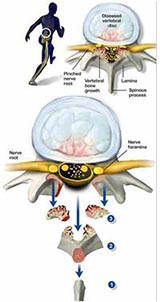 When pressure builds up in specific areas of your spinal column, it causes pain and other symptoms. Spinal stenosis, a narrowing of the spinal canal, is just one of the causes of this pressure. A herniated disc is another.
When pressure builds up in specific areas of your spinal column, it causes pain and other symptoms. Spinal stenosis, a narrowing of the spinal canal, is just one of the causes of this pressure. A herniated disc is another.
Laminectomy is a surgical procedure to remove the back portion of the vertebra called the lamina, which covers your spinal canal. A laminectomy also enlarges your spinal canal to relieve pressure on the spinal cord or root nerves. Laminectomy is most commonly performed on the lower back and in the neck.
This surgery is recommended only when more conservative care, such as medication and physical therapy, have failed to relieve your symptoms. Laminectomy may be in order to treat significant and worsening symptoms.
 If you've suffered a spinal fracture or have a tumor or infection that's causing compression of your spinal nerves, you can be in serious pain. One treatment, though surgically invasive, is a lumbar corpectomy. During this procedure, your spine surgeon removes almost all of the injured vertebra and disc. The physician often doesn't recommend this procedure as the first step, preferring to try more conservative care options first. If you're suffering from severe pain, however, a lumbar corpectomy may be the best solution.
If you've suffered a spinal fracture or have a tumor or infection that's causing compression of your spinal nerves, you can be in serious pain. One treatment, though surgically invasive, is a lumbar corpectomy. During this procedure, your spine surgeon removes almost all of the injured vertebra and disc. The physician often doesn't recommend this procedure as the first step, preferring to try more conservative care options first. If you're suffering from severe pain, however, a lumbar corpectomy may be the best solution.
Corpectomy can be done from the front or back. Now a day's corpectomy through all posterior approach, though complicated is being preferred as this is less morbid as compared to anterior approach.
 Most often, this minimally invasive surgery, also called a lumbar microdiscectomy is used to treat a herniated disc. The procedure is actually more effective for treating leg pain than lower back pain, because the root of the pain is in the lumbar area of your back.
Most often, this minimally invasive surgery, also called a lumbar microdiscectomy is used to treat a herniated disc. The procedure is actually more effective for treating leg pain than lower back pain, because the root of the pain is in the lumbar area of your back.
Lumbar disc microsurgery removes only the herniated portion of your disc. The surgeon uses a microscope and tiny instruments to minimize the trauma to the surrounding tissue. The surgeon removes only the part of the disc that's compressing your nerves, preserving most of your disc.
Sciatica, often caused by a compressed or impinged nerve in the lumbar area of your spine, can result in serious leg pain. A lumbar disc microsurgery can effectively treat sciatica when a conservative approach has failed.
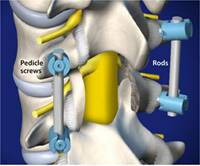 If you are suffering from back or leg pain, the source of that pain may be a damaged disc in your spine. In this procedure, your spine surgeon replaces the disc with metal/PEEK supports and bone grafts and put metallic screws. As a result, vertebrae above and below the removed disc fuse together.
If you are suffering from back or leg pain, the source of that pain may be a damaged disc in your spine. In this procedure, your spine surgeon replaces the disc with metal/PEEK supports and bone grafts and put metallic screws. As a result, vertebrae above and below the removed disc fuse together.
Posterior Lumbar inter-body fusion (PLIF) is an effective treatment for degenerative lumbar canal stenosis. At our institute the surgeon makes a smaller incision and uses smaller tools, thus minimizing damage to your lower back muscles.
In PLIF, the damaged disc is completely removed and replaced with material directly into the space left by the disc. The surrounding bone grows to fill in the space, creating a solid bridge that limits spinal movements.
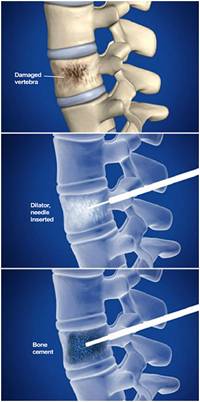 Vertebroplasty is a non-surgical therapy used to strengthen a broken or weakened vertebra or spinal bone. You may be a candidate for this procedure if you have a vertebra affected by osteoporosis or, less commonly, cancer.
Vertebroplasty is a non-surgical therapy used to strengthen a broken or weakened vertebra or spinal bone. You may be a candidate for this procedure if you have a vertebra affected by osteoporosis or, less commonly, cancer.
Vertebroplasty can increase your functional abilities, allow you to return to your previous level of activity and prevent further vertebral collapse. This therapy often successfully can alleviate the pain caused by a compression fracture.
At our institute we perform Vertebroplasty on an outpatient basis. The procedure basically strengthens a fractured vertebra by injecting an orthopedic cement mixture through a needle percutaneously into the bone.

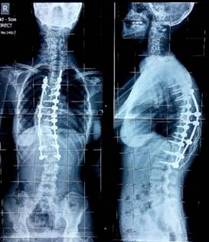 Scoliosis means sideways curvature of spine more than 10 degree. Usually growing age children are affected. Where their parents noticed a sideways bend or hump in their back. This bend sometimes increases rapidly. When indicated, this bend can be corrected with surgery for cosmesis. Here your spine surgeon does all preoperative investigations like X ray, CT scan and MRI and plan your surgical level. Your surgeon puts multiple screws in your tilted bones and then connects them with rods. This surgical procedure corrects your deformity fully or partially.
Scoliosis means sideways curvature of spine more than 10 degree. Usually growing age children are affected. Where their parents noticed a sideways bend or hump in their back. This bend sometimes increases rapidly. When indicated, this bend can be corrected with surgery for cosmesis. Here your spine surgeon does all preoperative investigations like X ray, CT scan and MRI and plan your surgical level. Your surgeon puts multiple screws in your tilted bones and then connects them with rods. This surgical procedure corrects your deformity fully or partially.
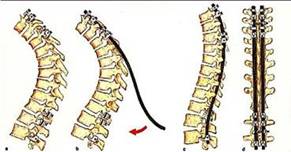 Kyphosis means forward bend in your spine. Sometimes due to various reasons like, congenital deformity, Scheuramann's disease, tuberculosis, neglected spine trauma, osteoporosis, degenerative conditions etc you get abnormal forward stoop in your spine. Usually it gives rise to pain, early tiredness and sometime weakness/ paralysis in your limbs. Depending upon severity of your deformity your spine surgeon plan the surgery, he puts screws and does corrective osteotomy or corpectomy and joins them with rods. Thus correcting your deformity.
Kyphosis means forward bend in your spine. Sometimes due to various reasons like, congenital deformity, Scheuramann's disease, tuberculosis, neglected spine trauma, osteoporosis, degenerative conditions etc you get abnormal forward stoop in your spine. Usually it gives rise to pain, early tiredness and sometime weakness/ paralysis in your limbs. Depending upon severity of your deformity your spine surgeon plan the surgery, he puts screws and does corrective osteotomy or corpectomy and joins them with rods. Thus correcting your deformity.
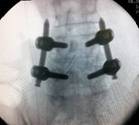 This surgery is a relatively newer technique. MIS means minimally invasive surgery. The indications for surgery are same as open lumbar fusion. This technique is particularly helpful in over weight patients. Here your surgeon with specialized retractors/ instruments creates small holes in your back to reach your spine. The surgery is being performed under microscope and specialized instruments. As there is minimal muscle and soft tissue trauma the patients post operative pain is less and recovery faster.
This surgery is a relatively newer technique. MIS means minimally invasive surgery. The indications for surgery are same as open lumbar fusion. This technique is particularly helpful in over weight patients. Here your surgeon with specialized retractors/ instruments creates small holes in your back to reach your spine. The surgery is being performed under microscope and specialized instruments. As there is minimal muscle and soft tissue trauma the patients post operative pain is less and recovery faster.